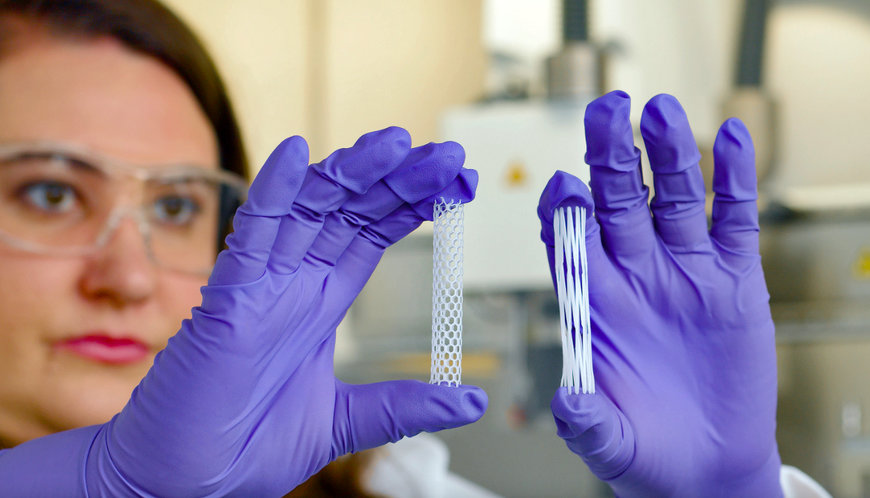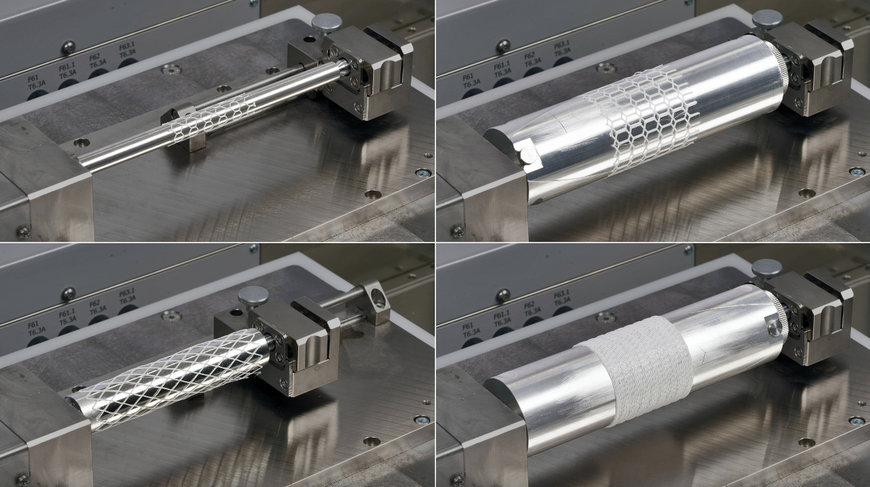www.medical-devices.tech
27
'23
Written on Modified on
DESKTOP METAL News
DESKTOP HEALTH INTRODUCES THE PRINTROLL ROTATING BUILD PLATFORM FOR THE 3D-BIOPLOTTER®
An innovative add-on feature for the 3D-Bioplotter, the PrintRoll platform was designed to enable 3D printing of cylindrical medical solutions for adults and children and therefore offers a range of standard and custom drum diameters.

Nicole Black, Ph.D., VP of Biomaterials and Innovation at Desktop Health, examines two tubular medical devices printed on the new 3D-Bioplotter® PrintRoll™ rotating build platform in medical-grade materials. PrintRoll is designed to enable new medical solutions for the body’s thousands of miles of internal channels, such as vascular, digestive, and other systems. (Photo: Business Wire)
Desktop Health — the trusted production-grade medical 3D printing brand of Desktop Metal, Inc. — announced a breakthrough in bioprinting with the launch of PrintRoll™, an innovative rotating build platform that can produce intelligent tubular solutions for the body’s vascular, digestive, respiratory, and reproductive channels on the 3D-Bioplotter premier bioprinting system.
The 3D-Bioplotter is a highly sophisticated extrusion-based 3D printer that processes liquids, melts, pastes, gels, or other materials, including cells, through a needle tip on a Swiss-made, 3-axis gantry system with high accuracy and temperature, sterility, and design controls. 3D-Bioplotter offers eight printheads with the widest range of temperatures in bioprinting — from 2°C to 500°C (35.6°F to 932°F) — enabling complex, multi-material medical parts.
The PrintRoll add-on feature has been in development since 2019 as part of a collaboration with Johannes Gutenberg University Mainz, a public research university in Mainz, Germany.
How PrintRoll Works
The PrintRoll platform attaches to the modular build plate of the 3D-Bioplotter and features a motor-driven rotating mandrel with spring-loaded, easily exchangeable drums of different sizes. Rotating speed is tightly controlled by the 3D-Bioplotter’s easy-to-use software.
As the PrintRoll tool rotates, the printhead moves back and forth depositing material on the surface in the desired design. For example, polycaprolactone (PCL), a medical-grade, biodegradable plastic used in many FDA-cleared implants and devices, hardens quickly on the drum after the melted material is printed. In bioprinting, users typically produce a structure or scaffold in a stiff or flexible biocompatible material that is designed to repair and integrate with cells of the body, sometimes degrading after a certain period of time.
The PrintRoll comes with a 10 mm diameter drum – with 20 mm and 40 mm sizes available – designed to accommodate the development of solutions for a variety of human channels, which vary based on age and gender. Standard diameter sizes generally correspond to the diameters of the femoral artery (~10 mm), trachea (~10-20 mm), fallopian tube (~5-15 mm), aorta (~25 mm) esophagus (~30 mm), and a range of intestine segments (~40-100 mm).
The PrintRoll system supports printing hollow cylindrical structures up to 140 mm in length, depending on the printhead used. Custom sizes may also be available.

The PrintRoll™ rotating build platform for use with the Desktop Health 3D-Bioplotter is designed to bioprint complex cylindrical medical devices of different diameters, customized to the needs of young and adult patients. The device will enable bioprinting of medical solutions for the body’s thousands of miles of vascular, digestive, respiratory, and reproductive channels. (Photo: Business Wire)
3D-Bioplotter® Continues Pioneering Bioprinting
PrintRoll continues the long history of bioprinting innovations on the world’s most researched bioprinting system, as detailed in the last 3D-Bioplotter brochure.
This tradition is also continued with CMFlex™ — the first 3D-printed regenerative bone graft substitute product cleared by the FDA and the first such clearance based on manufacturing on the 3D-Bioplotter. Developed by Dimension Inx, CMFlex is an easy-to-use flexible bone graft product that is 3D printed on a standard 3D-Bioplotter Manufacturer model. This new product is an alternative to an autograft, in which a physician intrusively harvests bone from one area of a patient’s body to repair damaged or diseased bone elsewhere in the body.
Desktop Health — the trusted production-grade medical 3D printing brand of Desktop Metal, Inc. — announced a breakthrough in bioprinting with the launch of PrintRoll™, an innovative rotating build platform that can produce intelligent tubular solutions for the body’s vascular, digestive, respiratory, and reproductive channels on the 3D-Bioplotter premier bioprinting system.
The 3D-Bioplotter is a highly sophisticated extrusion-based 3D printer that processes liquids, melts, pastes, gels, or other materials, including cells, through a needle tip on a Swiss-made, 3-axis gantry system with high accuracy and temperature, sterility, and design controls. 3D-Bioplotter offers eight printheads with the widest range of temperatures in bioprinting — from 2°C to 500°C (35.6°F to 932°F) — enabling complex, multi-material medical parts.
The PrintRoll add-on feature has been in development since 2019 as part of a collaboration with Johannes Gutenberg University Mainz, a public research university in Mainz, Germany.
How PrintRoll Works
The PrintRoll platform attaches to the modular build plate of the 3D-Bioplotter and features a motor-driven rotating mandrel with spring-loaded, easily exchangeable drums of different sizes. Rotating speed is tightly controlled by the 3D-Bioplotter’s easy-to-use software.
As the PrintRoll tool rotates, the printhead moves back and forth depositing material on the surface in the desired design. For example, polycaprolactone (PCL), a medical-grade, biodegradable plastic used in many FDA-cleared implants and devices, hardens quickly on the drum after the melted material is printed. In bioprinting, users typically produce a structure or scaffold in a stiff or flexible biocompatible material that is designed to repair and integrate with cells of the body, sometimes degrading after a certain period of time.
The PrintRoll comes with a 10 mm diameter drum – with 20 mm and 40 mm sizes available – designed to accommodate the development of solutions for a variety of human channels, which vary based on age and gender. Standard diameter sizes generally correspond to the diameters of the femoral artery (~10 mm), trachea (~10-20 mm), fallopian tube (~5-15 mm), aorta (~25 mm) esophagus (~30 mm), and a range of intestine segments (~40-100 mm).
The PrintRoll system supports printing hollow cylindrical structures up to 140 mm in length, depending on the printhead used. Custom sizes may also be available.

The PrintRoll™ rotating build platform for use with the Desktop Health 3D-Bioplotter is designed to bioprint complex cylindrical medical devices of different diameters, customized to the needs of young and adult patients. The device will enable bioprinting of medical solutions for the body’s thousands of miles of vascular, digestive, respiratory, and reproductive channels. (Photo: Business Wire)
3D-Bioplotter® Continues Pioneering Bioprinting
PrintRoll continues the long history of bioprinting innovations on the world’s most researched bioprinting system, as detailed in the last 3D-Bioplotter brochure.
This tradition is also continued with CMFlex™ — the first 3D-printed regenerative bone graft substitute product cleared by the FDA and the first such clearance based on manufacturing on the 3D-Bioplotter. Developed by Dimension Inx, CMFlex is an easy-to-use flexible bone graft product that is 3D printed on a standard 3D-Bioplotter Manufacturer model. This new product is an alternative to an autograft, in which a physician intrusively harvests bone from one area of a patient’s body to repair damaged or diseased bone elsewhere in the body.
www.desktopmetal.com


